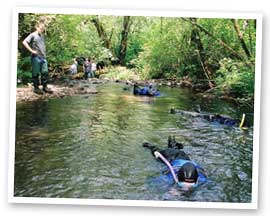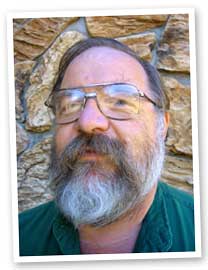 INSTITUTE FOR NATURAL RESOURCES
INSTITUTE FOR NATURAL RESOURCESYou are here
Salmon and Other Fish
- Intro
- Planning Resources
- Research Projects
- Articles & Stories
- Maps & Tools
- Reports & Publications
- Data
- Photos & Videos
- More
How Many Fish? A Story of Rapid Bioassessment
In the mid-1980s, the need for cost-effective biological survey techniques arose because of rapidly dwindling resources for monitoring and assessment and the extensive miles of unassessed stream miles along Oregon's North Coast. It was also recognized that the biological data needed to make informed decisions relevant to these watersheds was greatly lacking. Further, it was crucial to collect, compile, analyze, and interpret environmental data rapidly to facilitate management decisions.

Snorkeling
(Oregon Department of Fish and Wildlife)
Rapid Bioassessment (RBA) grew from these needs and has become one of the standard methods to gather biological data for several reasons. It provides for multiple site investigations in a field season. It offers quick turn-around of results for management decisions. The results are easily translated to land managers and the public. And, unlike electro-fishing, the procedures are not environmentally harmful.
RBA involves snorkeling every fifth pool along a stream and recording counts of juvenile fish observed. The MidCoast Watersheds Council has used RBA extensively since 1998 to obtain a detailed geographic picture of where salmon live in the watersheds and to help prioritize restoration and recovery efforts.

Wayne Hoffman, Coordinator of the
MidCoast Watersheds Council
(John Ame)
The MidCoast Watersheds Council has published several reports which evaluate the accuracy of RBA methods. They found that RBA inventories for coho salmon during the summer are replicable and typically underestimate the actual number by less than 20 percent. The Council has identified 800 miles of summer coho habitat within its boundaries.
The process of conducting Rapid Bioassessment surveys has also greatly increased our understanding of juvenile salmon behavior. We have learned that at stream temperatures below 5 degrees Celsius, older steelhead and cutthroat trout are almost entirely associated with complex cover and can only be observed sporadically during daylight hours. Lower main stem streams, which have low water velocities along the streams edges, provide the entire winter rearing habitat for these species. Virtually no juvenile salmon rear in the main channel. Finally, riparian vegetation, including sedges, willow, and exposed rootmats, play an important role in providing cover for low-velocity edge habitats.
RBAs conducted in the Green River watershed have illustrated the importance of large woody debris. In 2001, surveys showed winter coho populations at only 28% of the population observed during summer surveys. The MidCoast Council worked with a number of partners to place 400 logs by helicopter in the Green River in 2002. Later that year, winter populations were higher"”55% of the summer population numbers. And one year later, during the winter of 2003, RBAs determined that winter populations are holding at approximately 50% of the observed summer populations. RBA has also provided a deeper understanding of how coho relate to the estuarine environment, how they handle flood events, and the importance of large woody debris.
For more information, see the MidCoast Watersheds Council website.










